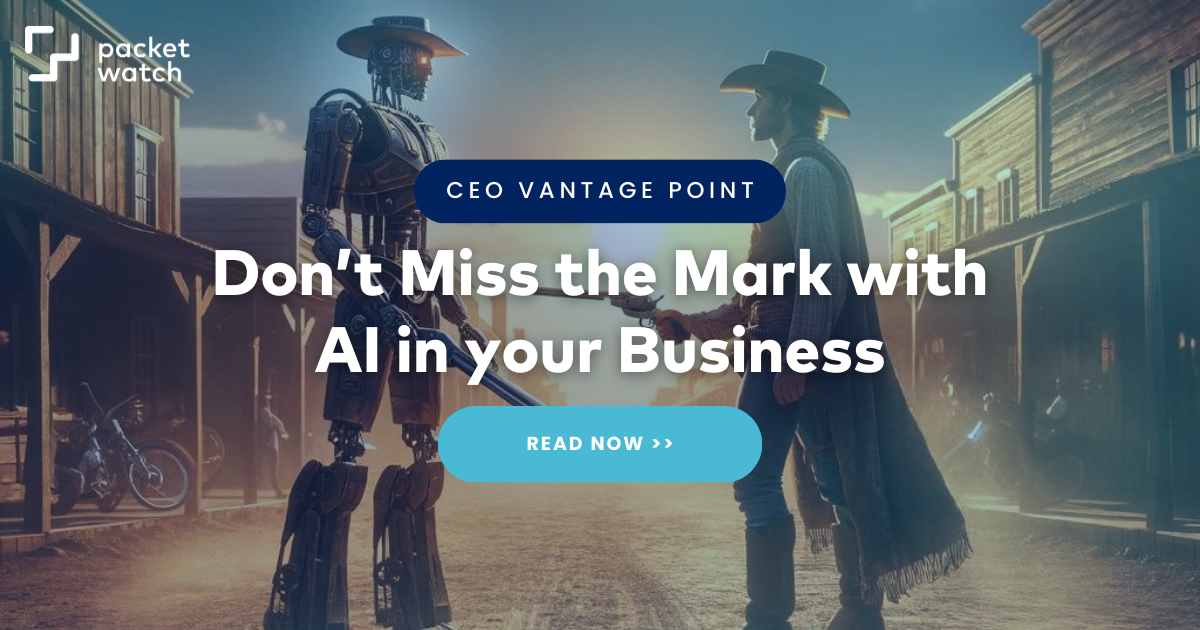
This month, PacketWatch CEO Chuck Matthews explores the parallels between the Wild West's challenges and opportunities and today's Artificial Intelligence (AI) landscape in business, emphasizing the importance of robust governance and regulatory alignment to responsibly harness AI's vast potential.
I noticed snowflakes were falling in Tombstone, Arizona, last week. Tombstone is about 3 ½ hours southeast of PacketWatch’s HQ in Scottsdale.
Back in 1881, Tombstone was the site of the famous gunfight a few doors down from the OK Corral. The fight lasted less than a minute but symbolized the unconquered and often unruly western territories back in the day.
The promises of independence, vast riches, and boundless opportunity drew all types of people to the uncharted Western territories. Some good and some bad. What they often found was a hard life with many unexpected challenges. A few found enormous riches, but many more starved or barely eked out an existence. Enormous promises didn't guarantee a good outcome for all.
While preparing remarks for a business leadership group on artificial intelligence (AI), I noticed the photo. As I reflected, I thought of several analogies between the Wild West and the present state of AI in business.

Graphic courtesy of DALL⋅E
Taming the Wild West (of AI)
Law enforcement in the western territories was spread thin across vast areas. Outlaws and gangs challenged law enforcement, constantly testing the limits of law and order. Reports of this wild and rowdy lifestyle were made known to the world in newspapers. The western territories were fiercely independent and unruly. In the 1930s, the biography of Wyatt Earp told the story of Tombstone. Regulations were struggling to keep up with new issues across the territories.
Similarly, AI usage is testing the limits of the law and regulation today. There are new issues and concerns with an emerging technology that few can venture to explain. Concurrent with implementing these new tools and techniques, all levels of government feel compelled to act. Last year, the Whitehouse, Congress, and 18 states enacted various laws and regulations affecting AI. The EU did as well.
📊 McKinsey & Company reports that 1/3 of firms already use generative AI tools.
The leading use cases involve customer operations, marketing and sales, software engineering, and research and development. Each of these involves sensitive data and intellectual property.
- How well do your organization’s policies and AI governance align with the emerging regulatory environment?
- Will your organization find itself on the wrong side of these rapidly changing laws?
A sound governance program should be the starting point, not something to address after the horses have left the corral.
The Promise of Vast Riches
The western land rush and the gold rush promised immense wealth for newcomers across the western territories. Gangsters, bandits, and outlaw gangs ravaged many in their pursuit of these dreams.
Similarly, McKinsey and Company’s research estimates “that generative AI could add the equivalent of $2.6 trillion to $4.4 trillion annually … by comparison, the United Kingdom’s entire GDP in 2021 was $3.1 trillion.”
Those numbers reflect a huge opportunity. Those who get it right will prosper, and some will miss it altogether -- to their peril. Where the promise of money is huge, the temptation is to cut corners to speed implementation, which may cost more than a more methodical approach.
Ask Yourself
Consider the oversight of how AI is being used in your organization:
- Are there any guardrails in the platform?
- Which models are okay to use?
- Open source or proprietary?
- How safe is your training and testing data?
- What are the inherent biases of the models?
- Who looks for “drift” in the models?
- Are there stealth sleeper agents or latent, silent data errors lurking in your models? How do you know for sure?
- Does anybody audit the use of AI in your firm?
These are just a few questions to consider when developing your governance plan.
Conclusion
 The day of reckoning in Tombstone has long since passed, but the days of reckoning for AI are around the corner. The Board of Directors or the Regulators will (eventually) ask for your plans and governance models. “Ready, aim, fire” was how to succeed in a gunfight. That model still applies here.
The day of reckoning in Tombstone has long since passed, but the days of reckoning for AI are around the corner. The Board of Directors or the Regulators will (eventually) ask for your plans and governance models. “Ready, aim, fire” was how to succeed in a gunfight. That model still applies here.
Contact us today if you'd like to better understand AI implementation in the context of your organization.
ABOUT THE AUTHOR
Chuck Matthews is the CEO of PacketWatch, a US-based boutique cybersecurity firm focused on incident response, managed detection and response, forensics, and advisory services utilizing their proprietary network-based threat-hunting platform.
Posts by Tag
- CEO Perspective (30)
- Cybersecurity Resilience (12)
- Incident Response (12)
- Compliance (10)
- GRC (9)
- Vulnerability Management (7)
- Best Practices (5)
- Threat Hunting (5)
- Cyber Insurance (4)
- Artificial Intelligence (AI) (3)
- Full Packet Capture (3)
- HIPAA (3)
- Artificial Intelligence (2)
- Network Visibility (2)
- Ransomware (2)
- Critical Vulnerability (1)
- Cybersecurity Threats (1)
- Event (1)
- Legal Industry (1)
- Manufacturing Industry (1)
- Multi-factor Authentication (1)
- Security Risk Assessment (1)
- Threat Intel (1)
- Zero-Day (1)

.webp) Chuck Matthews
Chuck Matthews